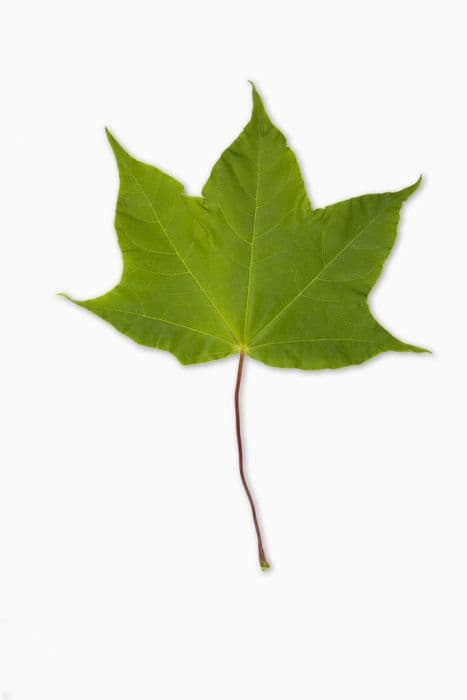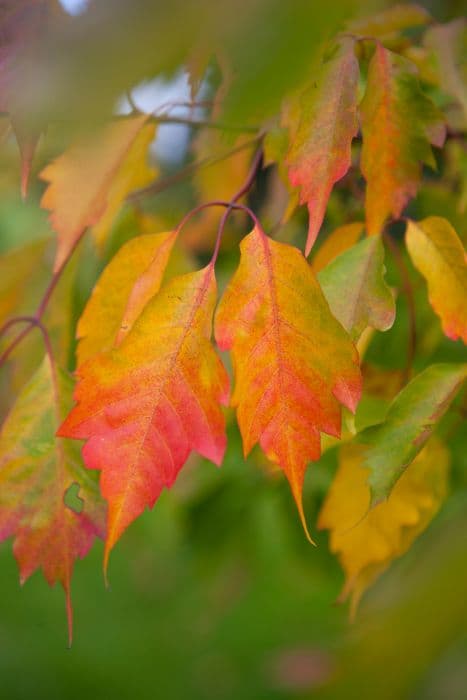Japanese Maple Acer palmatum 'Elegans' (M)

ABOUT
The Japanese maple 'Elegans' is a type of deciduous shrub known for its ornamental qualities and unique foliage. During the changing seasons, this plant showcases a range of colors that contribute to its visual interest. The leaves are deeply lobed with pointed tips, resembling a palm's structure, which is characteristic of many Japanese maple varieties. In spring, the foliage emerges with a soft purplish-pink hue, and as the season progresses, the leaves transition to a muted green, giving a serene and lush appearance. By fall, the leaves take on a dramatic transformation once more, with a display of fiery oranges and reds, providing an eye-catching splash of color in the landscape. The leaves of 'Elegans' are noted for their delicate texture and subtle colors that contrast beautifully with the darker branches. Its overall form is typically rounded and bushy, with a branching structure that can create an elegant, almost lace-like silhouette. The Japanese maple 'Elegans' also produces small flowers that may be less noticeable compared to its striking foliage, often followed by the development of winged seed pods, known as samaras, that dangle from the branches and provide additional visual interest.
About this plant
 Names
NamesFamily
Sapindaceae
Synonyms
Japanese Maple, Smooth Japanese Maple, Palmate Maple
Common names
Acer palmatum 'Elegans'
 Toxicity
ToxicityTo humans
The Japanese maple is generally not considered toxic to humans. There are no significant toxic effects reported for the ingestion of the leaves or other parts of this plant. Therefore, accidental consumption is not expected to result in poisoning or serious health consequences.
To pets
The Japanese maple is not known to be toxic to dogs, cats, or other pets. There is no evidence to suggest that ingestion of the leaves or other parts of this plant would lead to poisoning or adverse health effects in pets.
 Characteristics
CharacteristicsLife cycle
Perennials
Foliage type
Deciduous
Color of leaves
Varies
Height
6-8 feet (1.8-2.4 meters)
Spread
6-8 feet (1.8-2.4 meters)
Plant type
Tree
Hardiness zones
5-9
Native area
Japan
Benefits
 General Benefits
General Benefits- Enhances Landscape Aesthetics: Offers attractive foliage with colorful seasonal changes.
- Provides Shade: Mature trees can offer a cool, shaded area in gardens and landscapes.
- Supports Wildlife: Offers habitat and food for birds and insects.
- Increases Property Value: Mature and well-maintained trees are desirable in landscaping and can increase property value.
- Promotes Biodiversity: Introduces variety to plant life in a garden setting, supporting a diverse ecosystem.
- Creates Privacy: Can be used as a screen to increase privacy from neighbors or street views.
- Cultural Significance: Japanese maples are often used in traditional Japanese gardens, adding cultural interest to landscaping projects.
 Medical Properties
Medical PropertiesThis plant is not used for medical purposes.
 Air-purifying Qualities
Air-purifying QualitiesThis plant is not specifically known for air purifying qualities.
 Other Uses
Other Uses- The delicate branches of Acer palmatum 'Elegans' can be used in fine woodworking and inlay work due to their interesting color and grain patterns.
- The leaves, when pressed and dried, are often used in scrapbooking and other paper crafts for their unique shapes and colors.
- Acer palmatum 'Elegans' can be trained into a bonsai, offering a miniature landscape aesthetic for enthusiasts and bringing a sense of tranquility.
- During autumn, when leaves change color, they can be gathered to create natural and biodegradable confetti for autumn-themed celebrations.
- The wood from pruned branches can be reclaimed to create musical instruments such as woodwind instruments due to its acoustic properties.
- The seeds, known as samaras, can be used in decorative art for their distinctive shapes and as elements in jewelry making.
- Fine branches and twigs can be incorporated into floral arrangements and wreaths for their graceful form and texture.
- The foliage can be used as a subtle, natural dye for fabrics, yielding a variety of colors depending on the mordant used.
- Japanese Maple is often used in photography and painting due to its picturesque form and vibrant seasonal colors, inspiring artists.
- The plant can be integrated into landscape design not only for its beauty but also as a natural privacy screen due to its dense foliage.
Interesting Facts
 Feng Shui
Feng ShuiThe Japanese Maple is not used in Feng Shui practice.
 Zodiac Sign Compitability
Zodiac Sign CompitabilityThe Japanese Maple is not used in astrology practice.
 Plant Symbolism
Plant Symbolism- Beauty: Acer palmatum, commonly known as Japanese Maple, 'Elegans' is renowned for its delicate and beautiful foliage, with intricate leaf patterns and stunning colors, making it a symbol of beauty and artistry in the plant world.
- Change: The Japanese Maple's leaves change vividly with the seasons, representing the ever-changing cycle of life, renewal, and the passage of time.
- Peace: The serene growth habit and graceful form of the Japanese Maple evoke a sense of calm and tranquility, often symbolizing peace and quiet contemplation.
- Balance: With its symmetrical growth and harmonious appearance, the Japanese Maple often symbolizes balance and unity, reflecting the equilibrium found in nature.
- Endurance: Despite its delicate appearance, the Japanese Maple is quite hardy, representing endurance and the ability to withstand challenges.
 Water
WaterFor the Japanese Maple 'Elegans', water the plant thoroughly when the topsoil feels dry to the touch, which generally means watering once every 7 to 10 days, but this can vary with climate and soil conditions. Use a watering can or hose to gently soak the soil at the base of the tree, avoiding wetting the foliage to prevent fungal diseases. The amount of water needed typically ranges between 1 to 2 gallons per watering session for young trees, but mature trees may require more depending on their size and the weather. During hot, dry spells, more frequent watering may be necessary, while in cooler, wetter periods, less frequent watering is required. Always ensure that the tree is planted in well-draining soil to prevent waterlogging.
 Light
LightThe Japanese Maple 'Elegans' prefers dappled sunlight or part shade to thrive, so the ideal spot is one that receives morning sun and afternoon shade or filtered sunlight throughout the day. Avoid placing it in a location where it is exposed to harsh afternoon sun, as intense light can scorch the delicate leaves.
 Temperature
TemperatureJapanese Maple 'Elegans' is hardy in temperatures as low as -10 degrees Fahrenheit, however, it thrives best when temperatures range from 60 to 80 degrees Fahrenheit. It can tolerate brief spikes above these temperatures, but prolonged heat above 90 degrees Fahrenheit can cause stress to the tree. Sheltered positioning can help protect it from extreme temperature variations.
 Pruning
PruningPrune the Japanese Maple 'Elegans' to remove dead or damaged branches, to shape the plant, and to encourage a strong structure. The best time for pruning is in the late winter or early spring while the tree is still dormant. Light pruning can also be done in mid-summer if necessary, but avoid heavy pruning at this time to prevent sap loss. Pruning every 2 to 3 years is typically sufficient for maintaining a graceful shape.
 Cleaning
CleaningAs needed
 Soil
SoilJapanese Maple 'Elegans' thrives in well-draining, fertile soil with a pH of 5.5 to 6.5. A good mix would be equal parts loamy soil, peat moss, and coarse sand to promote aeration and prevent root rot. Mulching is beneficial to retain moisture and provide nutrients.
 Repotting
RepottingJapanese Maples should be repotted every 2-3 years, ideally during the late winter or early spring when they are dormant. Carefully transfer 'Elegans' to a slightly larger pot with fresh soil mix to encourage healthy growth.
 Humidity & Misting
Humidity & MistingJapanese Maple 'Elegans' prefers average to high humidity levels but is adaptable to a range of conditions. A humidifier or pebble tray can help maintain ideal humidity, especially if grown indoors or in a dry climate.
 Suitable locations
Suitable locationsIndoor
Keep 'Elegans' Japanese Maple near a bright window; moist, well-draining soil.
Outdoor
Plant 'Elegans' Japanese Maple in dappled shade; protect from harsh winds.
Hardiness zone
5-9 USDA
 Life cycle
Life cycleAcer palmatum 'Elegans', commonly known as Japanese Maple 'Elegans', begins its life as a seed which, after stratification, germinates in the spring. The seedling emerges and establishes a root system, followed by the development of its characteristic palmate leaves. As a juvenile, the tree experiences rapid growth and with proper conditions, will incrementally develop a branching structure and gain height each year. Transitioning into maturity, the tree produces flowers and then samaras, the winged seeds, typically by mid to late spring. The adult Japanese Maple 'Elegans' will continue to grow slowly, focusing on thickening its woody structure and expanding its canopy. With a lifespan that can exceed 100 years if properly cared for, the tree eventually will reach its senescence stage, characterized by a gradual decline in vigor and reproductive ability until it ultimately dies.
 Propogation
PropogationPropogation time
Spring-Early Summer
The Japanese maple 'Elegans' is typically propagated by softwood cuttings taken in early to mid-summer. To accomplish this, select a healthy, non-flowering shoot and cut a piece 4 to 6 inches (10-15 cm) long. The base of the cutting should be sliced just below a leaf node, and the lower leaves should be removed. Dip the cut end in rooting hormone to encourage root development. Then, plant the cutting in a pot filled with a well-draining soil mix. The pot should be placed in a warm area with indirect light and covered with plastic to maintain humidity. It’s important to keep the soil consistently moist but not waterlogged. Roots typically develop in a few weeks, after which the new plant can be gradually acclimatized to normal conditions before being transplanted outdoors.








